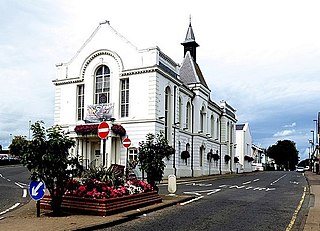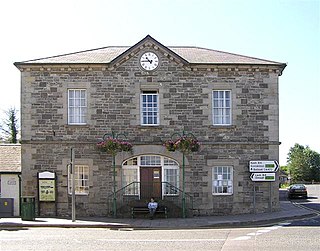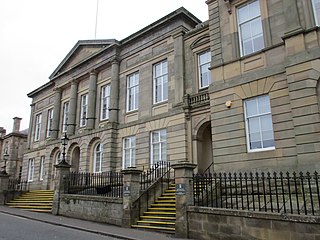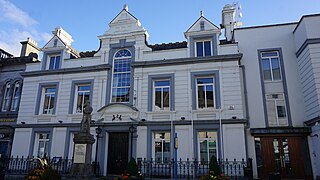
The Corn Exchange is a commercial building on The Payment in St Ives, Cambridgeshire, England. The structure, which is currently used as an events venue, is a Grade II listed building.

Queensland National Bank is a heritage-listed former bank building at 327 Kent Street, Maryborough, Fraser Coast Region, Queensland, Australia. It was designed by Frederic Herbert Faircloth and built from 1914 to 1915 by James Treevan and N C Steffensen. It is also known as Burrum Shire Council Chambers and Woodstock House. It was added to the Queensland Heritage Register on 21 October 1992.

Carrickfergus Town Hall is a municipal structure in Joymount in Carrickfergus, County Antrim, Northern Ireland. The town hall, which was the headquarters of Carrickfergus Borough Council, is a Grade B+ listed building.

Ballymoney Town Hall is a municipal structure in the High Street, Ballymoney, County Antrim, Northern Ireland. The structure, which incorporates a local history museum, is a Grade B1 listed building.

Long Eaton Town Hall is a municipal building in Derby Road, Long Eaton, Derbyshire, England. The town hall, which currently serves as one of two meeting places of Erewash Borough Council, is a Grade II* listed building.

Seaton Town Hall was a municipal building in Fore Street, Seaton, Devon, England. The former Town Hall, which was the meeting place of Seaton Urban District Council, currently hosts The Gateway Theatre, providing live music, theatre, cultural and community events.

Garstang Town Hall is a municipal building in the High Street in Garstang, Lancashire, England. The structure, which currently accommodates two shops and a Royal British Legion Club, is a Grade II listed building.

Grove House, also known as Dunstable Municipal Offices, is a municipal building in High Street North, Dunstable, Bedfordshire, England. The building, which forms the offices and meeting place of Dunstable Town Council, is a Grade II listed building.

The Town House is a municipal building in Union Street in Yeovil, Somerset, England. The building, which is the meeting place of Yeovil Town Council, is a Grade II listed building.

Lloyds Bank is a Grade II listed building at 19 Eastgate Street, Gloucester, Gloucestershire, England. It was grade II listed on 15 December 1998.

Ederney Town Hall, also styled as Ederney Townhall, is a municipal structure in Market Street, Ederney, County Fermanagh, Northern Ireland. The structure, which is used as a community events venue, is a Grade B1 listed building.

Donaghadee Town Hall, also known as The Merchant House, is a municipal structure in the High Street, Donaghadee, County Down, Northern Ireland. The structure, which has been converted for residential use, is a Grade B+ listed building.

Coldstream Town Hall is a municipal building in the High Street, Coldstream, Scottish Borders, Scotland. The structure, which currently accommodates a library and a registration office, is a Category B listed building.

Hamilton Sheriff Court is a judicial building in Almada Street, Hamilton, South Lanarkshire, Scotland. The building, which continues to serve as the local courthouse, is a Category A listed building.

Lanark Sheriff Court is a judicial building in Hope Street, Lanark, South Lanarkshire, Scotland. The building, which continues to serve as the local courthouse, is a Category B listed building.

The Corn Exchange is a commercial building in Market Street, Witney, Oxfordshire, England. The structure, which is used as a public events venue, is a Grade II listed building.

The Tholsel is a municipal building in West Street, Drogheda, County Louth, Ireland. Formerly the meeting place of Drogheda Borough Council, it is currently used as a tourist information office.

Clonmel Town Hall is a municipal building in Parnell Street, Clonmel, County Tipperary, Ireland. The building accommodated the offices of Clonmel Borough Council until 2014.

The Arch Building, previously known as Cobh Town Hall and before that as Queenstown Town Hall, is a municipal building in Casement Square, Cobh, County Cork, Ireland. The building currently accommodates a public library and a tourist information centre. It is included in Cork County Council's Record of Protected Structures.

Monaghan Town Hall, is a municipal building in Dublin Street, Monaghan, County Monaghan, Ireland. The building is currently used by Monaghan County Council as local municipal offices.






















